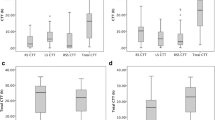Abstract
The abdominal distribution of orally ingested radioopaque markers is used to assess total and segmental colonic transit in constipated patients, but interpretation may depend on whether studies are carried out on a full colon or one cleared of faeces. We asked 25 severely constipated patients (age 18–74; 22 F, 3 M) to ingest 50 polyethylene markers (4 mm×2 mm) at breakfast on 2 occasions 1 month apart. No bowel preparation was used for study 1 but for the second study 2 doses of Sodium Picosulphate (2×10 mg) were taken 3 days before ingestion of the markers. All subjects reported a good result which had ceased a day before taking the markers. Marker distribution was assessed by a plain abdominal film taken 72 hours after ingestion. All 25 subjects had more than 50% of markers present at 72 h in study one. Of these 4 showed evidence of outlet obstruction with more than 50% of ingested markers in the rectum. In the remaining 21 subjects markers were distributed throughout the colon in a pattern indicating colonic inertia. Following the administration of purgative there was no significant change in the mean number of markers retained but patterns of marker distribution for individual subjects did alter. Of the 21 patients who previously had colonic inertia, 3 showed outlet obstruction and 1 showed no evidence of delayed transit. Of the 4 patients with a pattern of outlet obstruction in the first study, 2 showed no evidence of delayed transit after Picolax. The results of this study suggest that it may be necessary to carry out studies on both the unprepared bowel and after bowel clearance in order to obtain the maximum information from the distribution of markers.
Résumé
La distribution abdominale des pelets radioopaques ingérés est utilisée pour étudier le temps de transit colique total et segmentaire chez les malades constipés, mais l'interprétation peut dépendre du fait que l'examen est réalisé sur un colon plein ou un colon préparé. Nous avons demandé à 25 patients avec constipation sévère (âge 18–74, 22 femmes, 3 hommes) d'ingérer 50 pelets de polyéthylène (4 mm×2 mm) au petit déjeuner par deux fois à un mois d'intervalle. Aucune préparation n'a été utilisée pour l'étude 1 mais pour la seconde étude deux doses de Picosulphate de Sodium (2×10 mg) ont été données trois jours avant l'ingestion des marqueurs. Tous les sujets ont eu un bon résultat qui a céssé le jour avant la prise de marqueurs. La distribution des marqueurs a été étudiée sur un abdomen sans préparation pris 72 h après l'ingestion. Les 25 sujets avaient plus de 50% des marqueurs présents à la 72ème heure dans l'etude 1. Parmi eux 4 avaient à l'évidence une dischésie avec plus de 50% des marqueurs ingérés dans le rectum. Les 21 sujets restants avaient une distribution des marqueurs dans tout le colon suggérant une inertie colique. Après administration de purgatifs il n'y avait pas de différence significative du nombre moyen de marqueurs retenus mais l'aspect de la distribution des marqueurs chez chaque individu s'était modifié. Parmi les 21 patients qui avaient précédemment une inertie colique, trois montraient une obstruction terminale et un nqvait aucune évidence de ralentissement du transit. Parmi les 4 patients qui avaient un aspect de dyschésie sur la première étude deux n'avaient plus aucune évidence de transit retardé après Picolax. Les résultats de cette étude suggèrent qu'il peut être nécessaire de faire des études à la fois sur un colon non préparé et sur un colon préparé afin d'obtenir le maximum d'information sur la distribution des marqueurs.
Similar content being viewed by others
References
Hinton JM, Lennard-Jones JE, Young AC (1969) A new method for studying gut transit time using radioopaque markers. Gut 10:842–847
Martelli H, Devroede G, Arhan P, Dugay C (1978) Mechanisms of idiopathic constipation: Outlet obstruction. Gastroenterology 75:623–631
Martelli H, Devroede G, Arhan P, Dugay C, Dornic C, Faverdin C (1978) Some parameters of large bowel motility in normal man. Gastroenterology 75:612–661
Arhan P, Devroede G, Jehannin B, Lanza M, Faverdin C, Dornic C, Persoz B, Tetreault L, Perey B, Pellerin D (1981) Segmental colonic transit time. Dis Colon Rectum 24:625–629
Author information
Authors and Affiliations
Rights and permissions
About this article
Cite this article
Bergin, A.J., Read, N.W. The effect of preliminary bowel preparation on a simple test of colonic transit in constipated subjects. Int J Colorect Dis 8, 75–77 (1993). https://doi.org/10.1007/BF00299331
Issue Date:
DOI: https://doi.org/10.1007/BF00299331




